Pièce pour cinq interprètes at the Havana biennial: an interview with Stéphane Gilot and Ariane De Blois
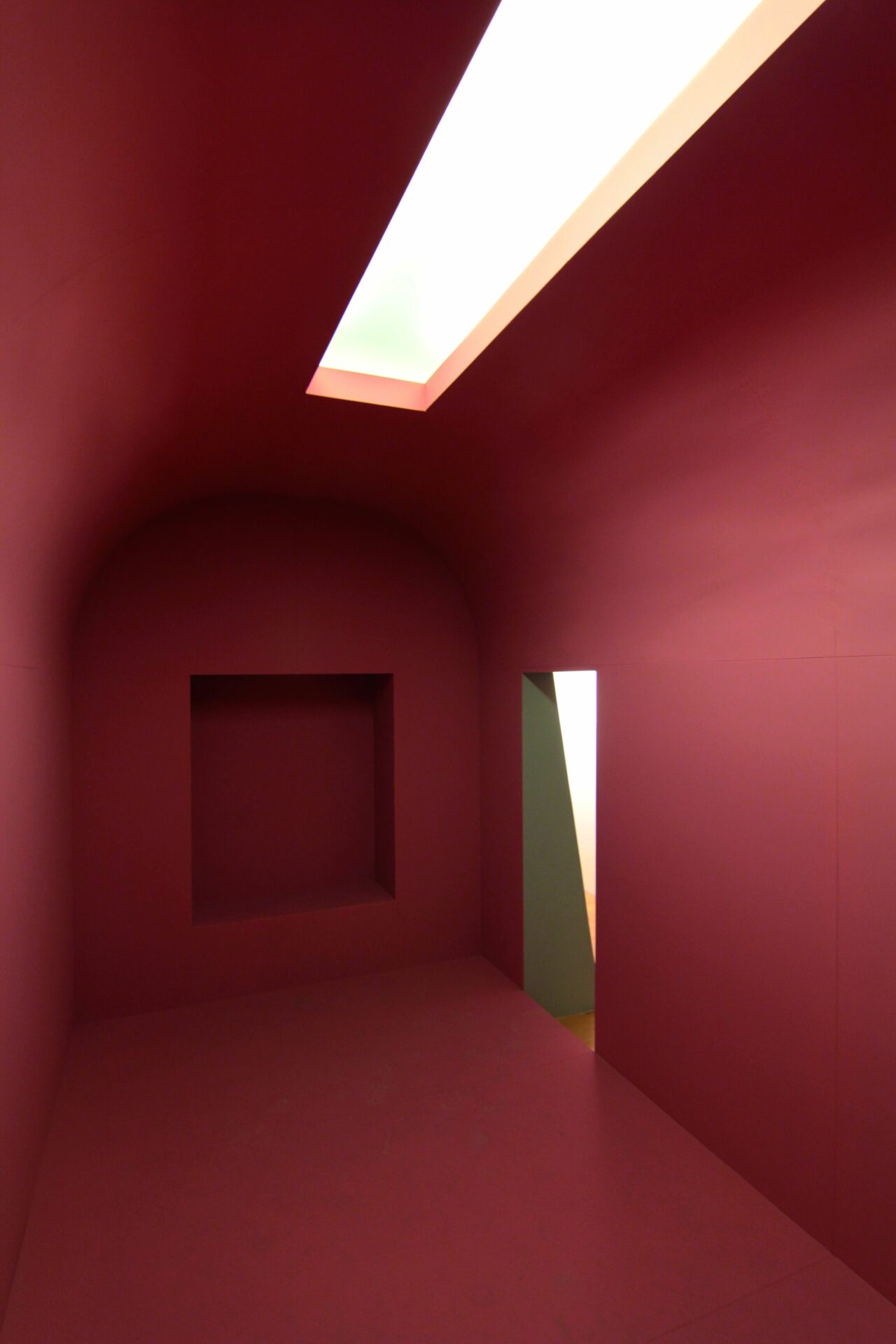
Photo : Caroline Boileau, courtesy of the artist
Presented in the spring of 2014 at pfoac221 (Pierre-François Ouellette art contemporain) in Montréal, the installation Pièce pour cinq interprètes, lumière rose et silence was created by Stéphane Gilot in close collaboration with curator Ariane De Blois. An immersive and poly-sensorial structure, midway between a bunker and meditative cell, the work will be presented at the 12th edition of the Havana Biennial, which has the theme “Between the Idea and Experience.” Advancing a transdisciplinary and intermedial perspective of art, the Biennial’s team of curators seek to contribute to the “displacement of the autonomous object to the context and experiences”1 1 - “12th Havana Biennial: Between the Idea and Experience.” Biennial Foundation (May 1, 2014), accessed March 1, 2015, www.biennialfoundation.org/2014/05/havana-biennial-2015-curatorial-concept/. by means of projects spread across the city that each, in their own way, generates interactions with the social fabric. This interview, conducted by correspondence, highlights the rationale of this multi-faceted project in order to elucidate the defining characteristics of its presentation on Cuban soil.
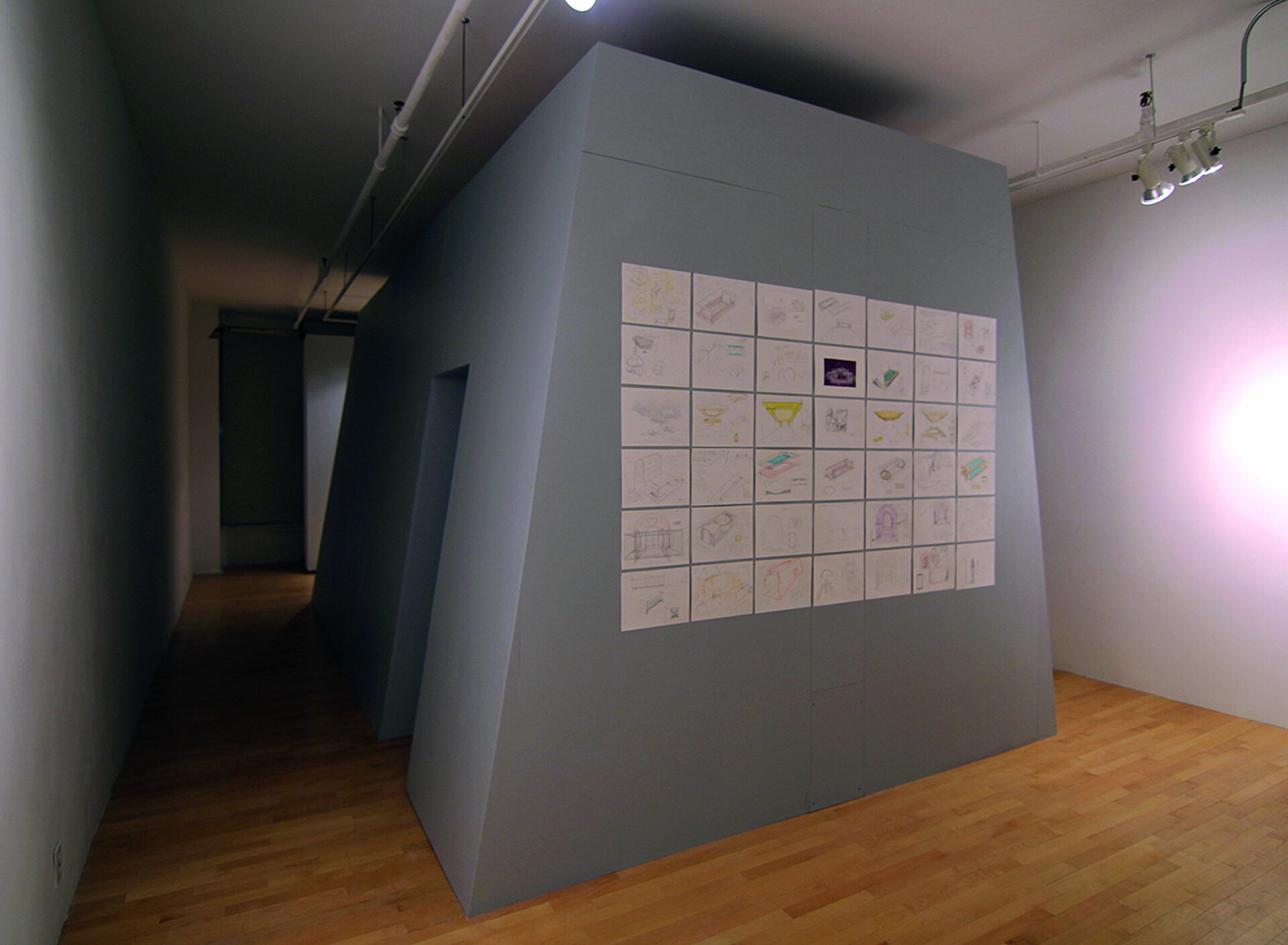
Pièce pour cinq interprètes, lumière rose et silence, 2014, installation view.
Photo : pfoac, courtesy of the artist
Aseman Sabet : Reading your correspondence, which served to present the work in 2014, it is possible to follow the initial development of the project and the threads that allowed you to elaborate its key ideas. Before delving more specifically into the work, what conceptual motivations and theoretical or practical research interests led you to work collaboratively?
Stéphane Gilot : When Pierre-François Ouellette suggested inviting a curator to develop a project for pfoac221, the article that Ariane De Blois had written on my exhibition MultiversitÉ/Métacampus, presented at Galerie de l’UQAM in the fall of 2012, immediately sprang to mind. This article touched on several questions that drive my practice and seemed a promising starting point for exchange for a carte blanche project of this kind. Ariane had examined my work in light of the “relationships that we maintain with the world and its organization” and the interplay “between the over-determination of the space and the defamiliarization of locations.”2 2 - Ariane De Blois, “Stéphane Gilot. MULTIVERSITÉ/Métacampus,” esse, no. 77 (Winter 2013): 70 – 71 (our translation).
Ariane De Blois : To my mind, Stéphane belongs in the great tradition of encyclopaedic artists. His work is the fruit of a synthesis of multiple influences, from the painting of Giotto to the architectural projects of Étienne-Louis Boullée, the theatre of Samuel Beckett, the cinema of Andrei Tarkovsky, the literature of Adolfo Bioy Casares, and the music of György Ligeti. To absorb and understand his work conceptually, I first had to familiarize myself with his multi-layered artistic and intellectual horizon. Since the concept of heterotopia3 3 - Michel Foucault, Dits et écrits 1984, “Des espaces autres” (conference, Cercle d’études architecturales, March 14, 1967), Architecture, Mouvement, Continuité, no. 5 (October 1984): 46 – 49, (our translation). — the idea of “another world” — is an overarching theme in his work, it was around this theme that our discussions mainly revolved. Our exchanges were quickly shaped by the sketches and ideas proposed by the artist, whose practice centres on two major series of works: Plans d’évasion (Escape Plans) and Mondes modèles (Model Worlds).
SG : The works in the first series, such as Free Will (2000–01), The Station (2006), and An Abode of Indiscernible Hue (2011), are performative installations that focus on diverse forms of utopia and dystopia, architecture, social structures, cosmology, and epistemology. Each escape plan is presented as a constructed environment, a hybrid space (combining uses with formal and metaphorical languages sometimes from contradictory fields) in which the spectators (or performers) can settle for a while. These works are, in some way, cells for transformation that offer the spectator a life experience.
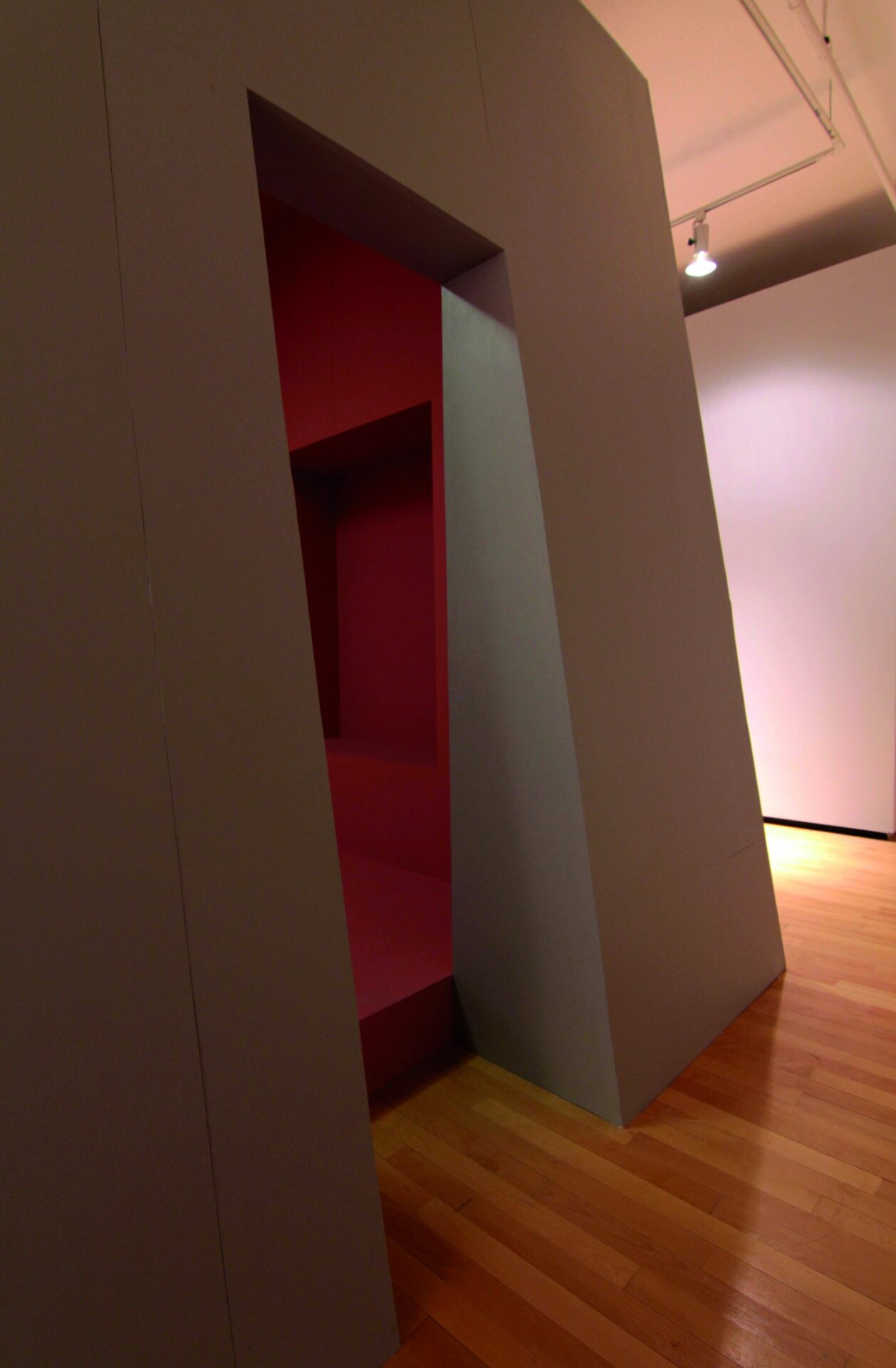
Pièce pour cinq interprètes, lumière rose et silence, 2014, installation view.
Photo : Caroline Boileau & pfoac, courtesy of the artist
The second series, Mondes modèles, which includes Performative City (2010–12) and My Kind of Fun is Darker than Yours (2013), complements the first through the notion of the model. Composed of various sets of architectural maquettes, this series in a sense constructs the meta-narrative of my practice over the past fifteen years. Each installation is a miniaturized urban environment that includes references to previous projects, including numerous escape plans.
AS : The collaborative principle inherent to the work is also suggested in its title, which makes reference to five performers. Different readings of these five protagonists are conceivable. What led you to this plural conception of the work and, more specifically, to the integration of a sound space also composed of various parts?
ADB : Stéphane’s work always offers several entry points, possible readings, and interpretations. The concept of the multitude is inherent to his practice, and it is around this that he constructs his “worlds,” be they in the form of models or escape plans. It therefore comes as no surprise that he is interested in scientific multiverse theories, which are also found in science fiction. Instead of trying to understand the whole of existence under a single principle — the Universe, which governs all laws — multiverse theories, in contrast, allow us to conceive of a totality of possible, coexisting universes. Stéphane could say more about the different meanings evoked by the title of the installation, but it is worth noting from the outset that if, due to its external architectural structure, Pièce pour cinq interprètes at first seems like a closed world, it nevertheless invites visitors to linger in its vaulted alcove, to become the protagonists of the work, and to inscribe it with their own interpretations.
SG : To a certain extent, the title acts as a lure. The cell constitutes a world — or the synthetic expression of a world — whose parameters and conditions of existence emerge from the association and collaboration of five specialists: gallery owner, curator, artist, technician, and sound specialist.
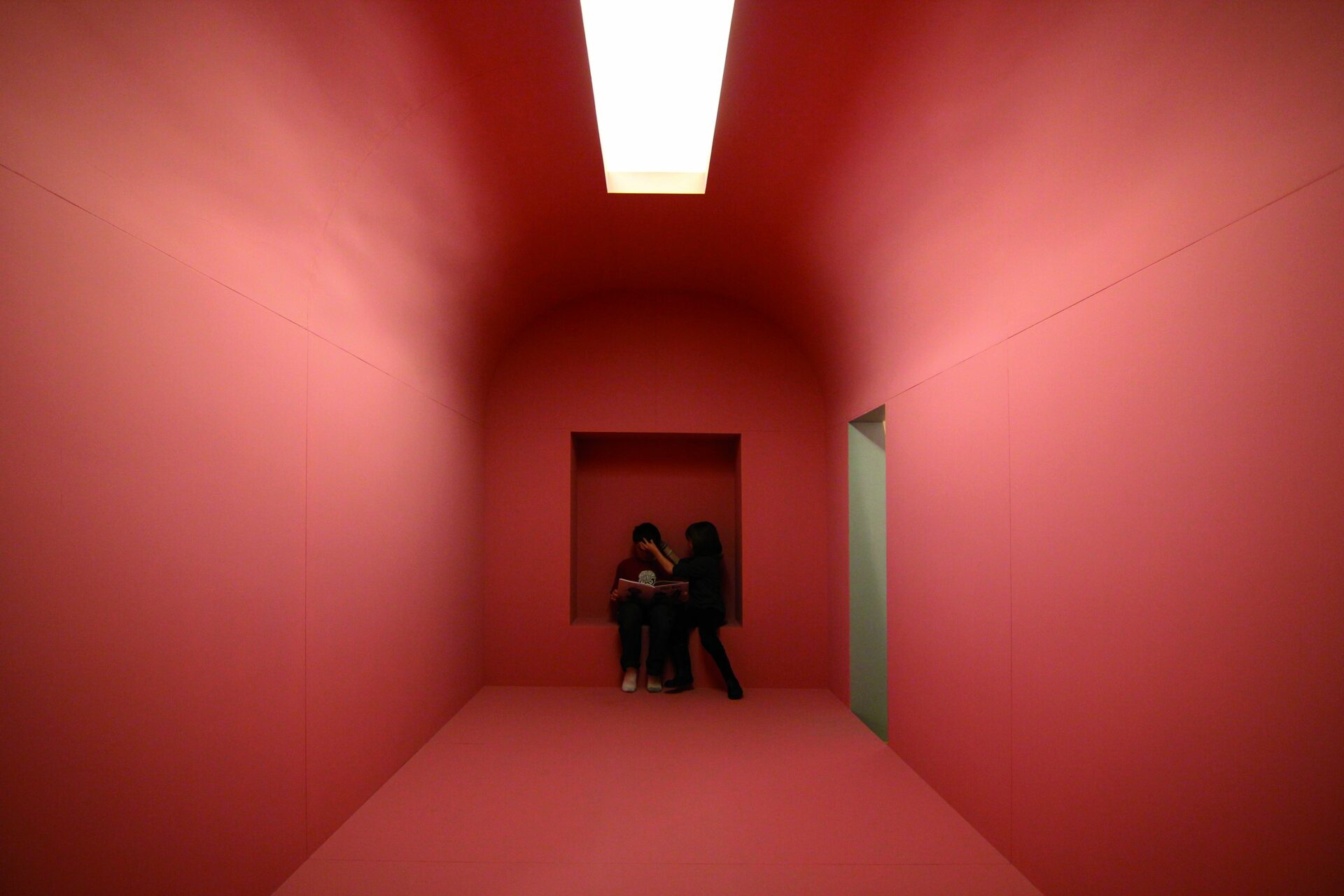
Pièce pour cinq interprètes, lumière rose et silence, 2014, installation view.
Photo : Caroline Boileau & pfoac, courtesy of the artist
The installation also features five structural motifs: two entrances placed diagonally opposite each other, two two-person alcoves that face each other in the interior, and a light shaft. Thus, the organization of the space implies four performers potentially seated in the alcoves. The fifth person, evoked in the title, is supernumerary: a presence that is temporarily one of waiting, of suspended choice; a presence that remains standing. The performers are the visitors.
As in previous installations, sound participates in the mise en fiction of the work. It is intrinsically linked with the “presence” that inhabits the space in which the project is installed. More specifically, the soundtrack reinforces what the space already creates (a gateway between the reality of the gallery and the city, and the parallel world of the cell), while allowing the temporal play between “present presence” and prior presence to evolve.
AS : Considering the theme of this biennial, “Between the Idea and Experience,” to what extent will Pièce pour cinq interprètes, lumière rose et silence — one of whose principal parameters is precisely the experience of the spectator — be adapted in view of its new presentation context? Will the soundtrack, originally composed by artist Magali Babin for the Belgo building in Montréal, still reinforce spatio-temporal blurring when the work is presented in its new location, the lobby of an art deco building in Havana?
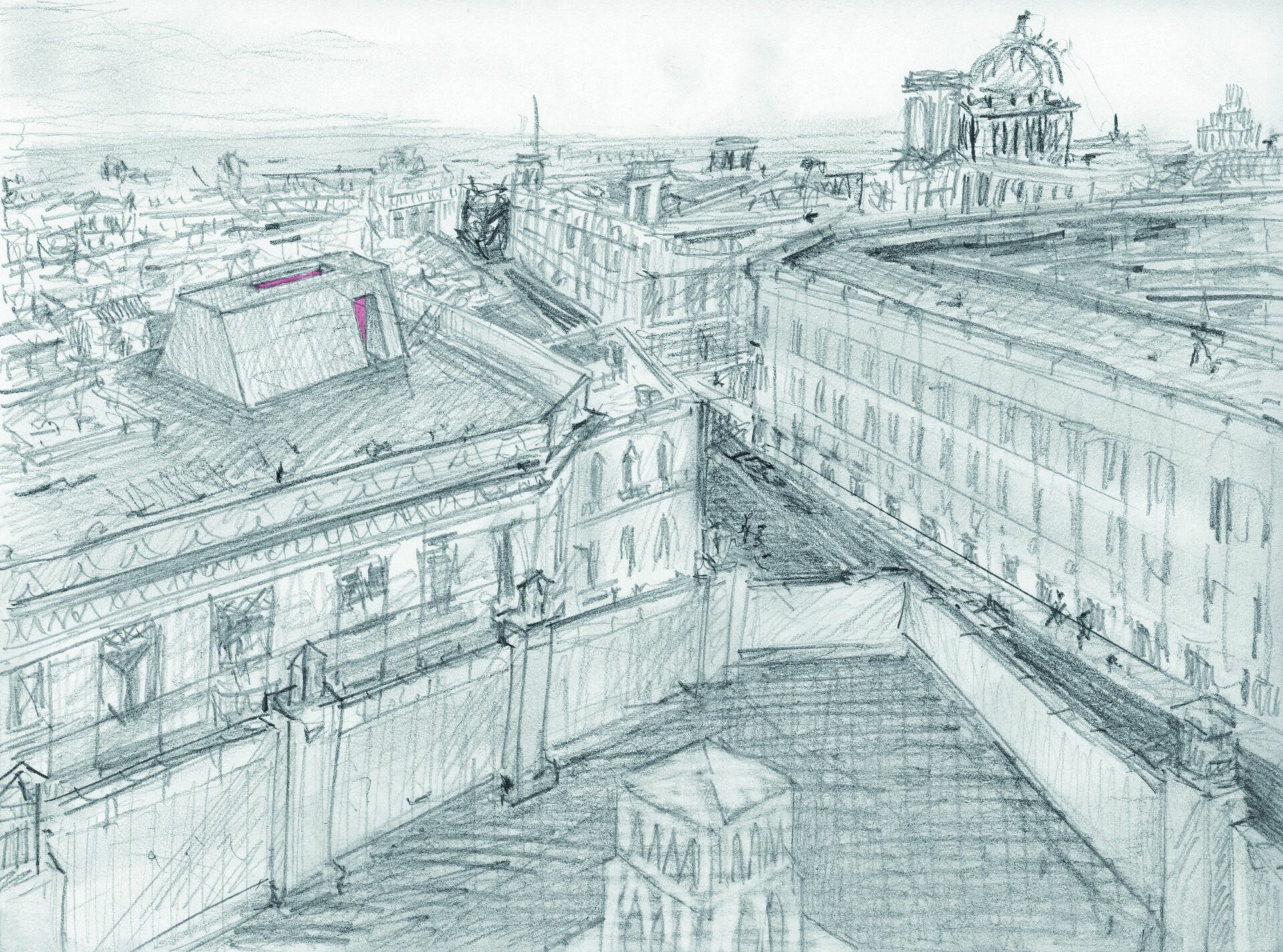
Depuis le Bacardi, 2015.
Photo : courtesy of the artist
ADB : Long before Stéphane was invited to participate in the Biennial and before knowing the theme of the event, our joint reflection on his practice, and what led to the conception of Pièce pour cinq interprètes, lumière rose et silence focused mainly on what transpires between the concept of a work, its materialization, and its experience. Diverse installation elements presented in Montréal sought explicitly to highlight this idea of the “between.” The installation, for example, was designed to bring into play notions of interiority and exteriority. While the exterior of the installation resembles a greyish bunker, the interior takes on the appearance of a vaulted cell in a lewd shade of pink. Affixed to one of the exterior walls, a series of preparatory sketches presented various potential projects that Stéphane had conceived of, thus reflecting what the project could have been. Comprising sounds captured in situ, the soundtrack, reverberating through the walls of the installation, sought to confuse the spectator about the origins of the sounds (were they real, imagined, or fictitious?). Since the structure of the installation will remain essentially the same for the Havana Biennial, what interests us, in presenting the work again, is to observe how the visitor’s experience of it can be considerably transformed by adapting certain elements, notably by changing the soundtrack and integrating a new series of drawings adapted to the presentation context.
SG : Presenting the work again in a radically different context, such as Havana, quickly revealed the paradox of an installation that uses context as medium, but that, at the same time, proposes an environment that offers an “exit” from everyday existence. It raises several questions: Is the experience of everyday life a universal experience despite the variety of contexts? Can everyday life in Montréal and Havana be approached unilaterally? The decision to produce a new soundtrack as well as a series of new drawings stems from these reflections. During a preproduction stay in Cuba in the winter of 2014, we were able to visit prospective locations, install the work, record sounds in situ, and conduct research for the graphic production. The idea of using the soundtrack to reinforce spatio-temporal blurring remains, but given that the soundscape of Havana differs from that of Montréal, the colour of the work, once inhabited by the sounds of the Cuban capital, will inevitably be modulated accordingly.

Dans les terres (d’après Esteban Chartrand)
Photo : courtesy of the artist
AS : The fact that the sketches accompanying the installation represent potential artworks allows us to imagine multiple variations of the structure or even the concept of the installation. From this perspective, can we envisage that Pièce pour cinq interprètes will open the way for a new series, which will be added to Plans d’évasion and Mondes modèles?
SG : Pièce pour cinq interprètes was created with the objective of extending the Plans d’évasion series. The variants presented did in fact introduce a subset of studies that in various ways qualify the issues at play in the project. These drawings also offered access to the ideation process, as well as to avenues for interpretations and readings. Their content refers to formal and conceptual sources, including proto-architecture, cosmology based on colours and geometry, and the notion of architecture as body. Presenting various possible proposals — mostly through drawings — is a principle that I regularly apply in my practice. Drawing also allows me to explore other thematic territories related primarily to visionary phenomena (hallucinations, altered states of consciousness, dreams, and urban prophecies, among others), outmoded theories and techniques (optograms and spirit photography, for example), and mnemonic reconstructions (memories, déjà vu).
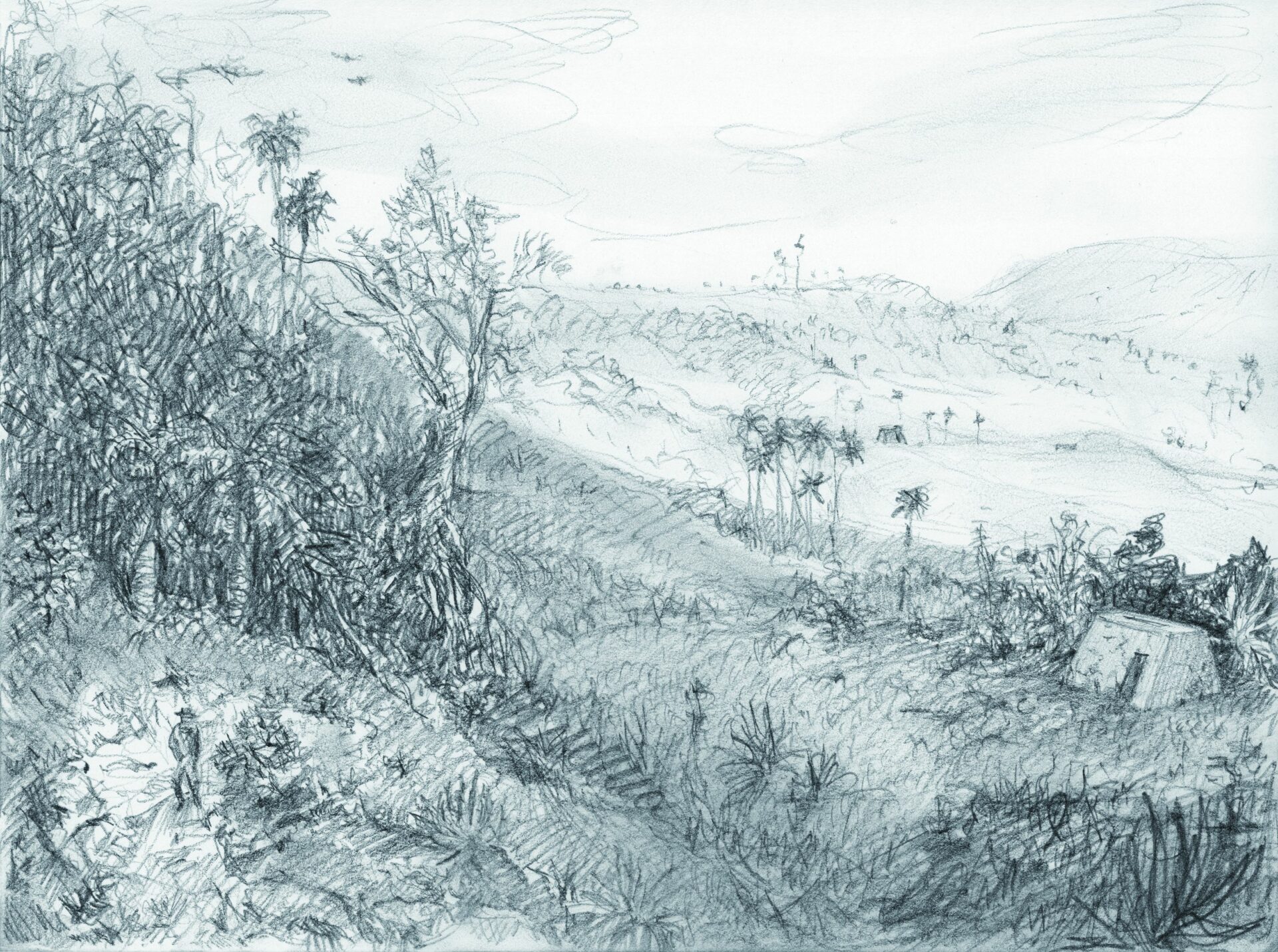
Dans les terres (d’après Esteban Chartrand)
Photo : courtesy of the artist
ADB : The new series of drawings that Stéphane produced for Havana anchors his installation in Cuba. From drawing to drawing, his “bunker-artwork” wanders Cuba’s varied landscapes (from the city to the countryside, by way of the seashore) and traverses different eras, taking on the appearance — depending on the surroundings — of a hut, a shelter, a boat, or a small modern house. Inspired by the nineteenth-century Cuban landscape paintings at the National Museum of Fine Arts of Havana, Stéphane also had the idea of introducing his installation into several of these paintings, notably those of Esteban Chartrand and Henri Cleenewerck, which particularly marked his imagination and which he cites in his drawings. Other sources of inspiration for this new series were his experience of Cuban life and the characteristics of the Havana region.
SG : Ultimately, this last question makes me wonder whether the protocols of the project — particularly in the context of a partial recasting of its components — actually break substantially with the parameters of Escape Plans, which would imply the creation of a new series.
Translated from the French by Louise Ashcroft


